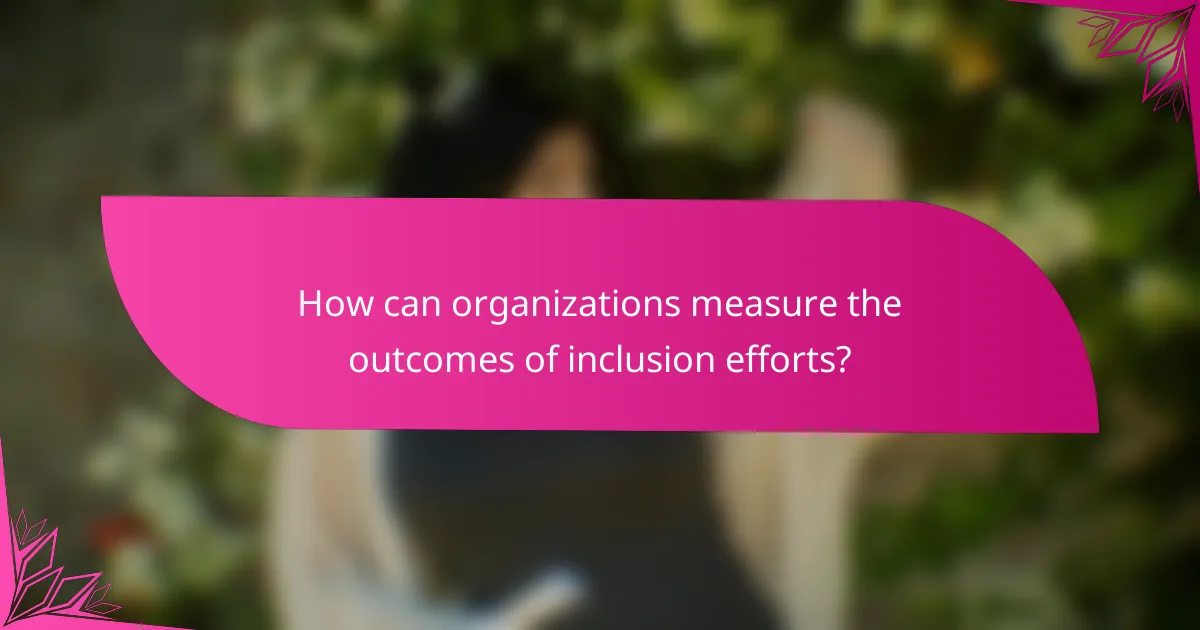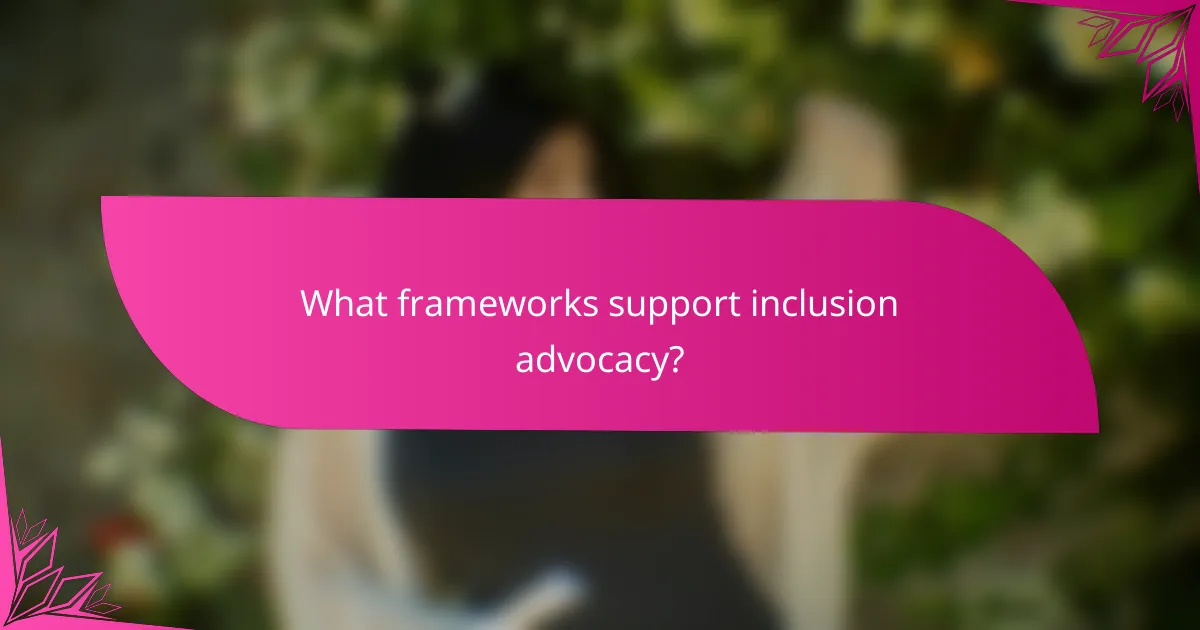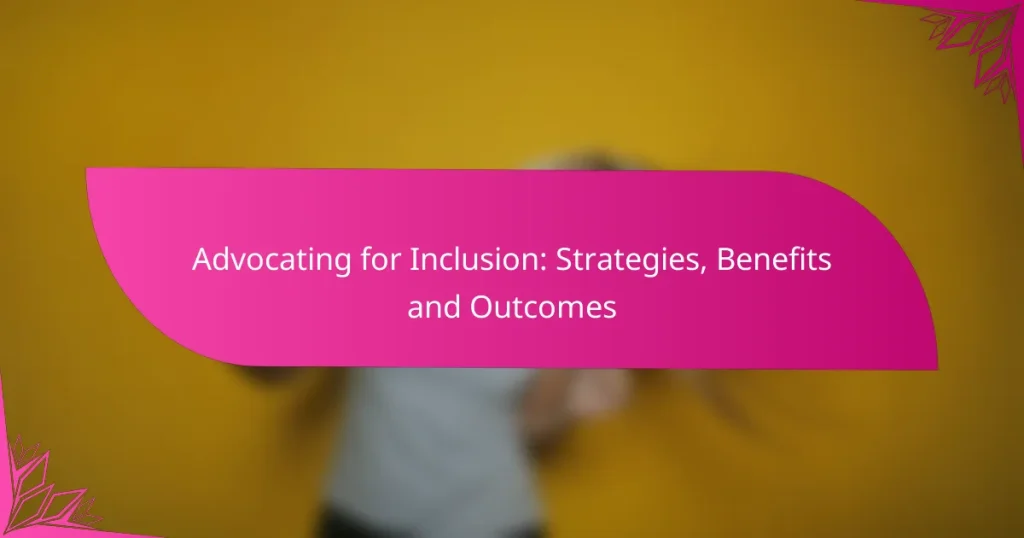Advocating for inclusion in the workplace is essential for fostering a diverse and harmonious environment that benefits both employees and organizations. By implementing targeted training, refining hiring practices, and promoting community through employee groups, companies can enhance workplace culture and productivity. The advantages of inclusion extend beyond morale, leading to improved engagement, innovation, and retention rates, ultimately contributing to organizational success.

What are effective strategies for advocating inclusion in workplaces?
Effective strategies for advocating inclusion in workplaces include implementing targeted training, refining hiring practices, and fostering community through employee groups. These approaches not only enhance workplace culture but also improve overall productivity and employee satisfaction.
Implementing diversity training programs
Diversity training programs are designed to educate employees about the importance of inclusion and the benefits of a diverse workforce. These programs typically cover topics such as unconscious bias, cultural competence, and effective communication across differences.
To be effective, training should be ongoing rather than a one-time event. Consider incorporating interactive elements like workshops or role-playing scenarios to engage participants and reinforce learning.
Creating inclusive hiring practices
Inclusive hiring practices focus on attracting a diverse range of candidates and ensuring equal opportunity throughout the recruitment process. This can involve using diverse hiring panels, crafting job descriptions that appeal to a broad audience, and utilizing platforms that reach underrepresented groups.
Additionally, consider implementing blind recruitment techniques, where identifying information is removed from resumes to minimize bias. Regularly reviewing hiring data can help identify gaps and improve future practices.
Establishing employee resource groups
Employee resource groups (ERGs) provide a platform for employees with shared characteristics or experiences to connect and support one another. These groups can foster a sense of belonging and provide valuable insights to management regarding the needs of diverse employees.
To establish effective ERGs, ensure they have clear objectives, adequate resources, and support from leadership. Encourage participation by promoting the benefits of joining these groups, such as networking opportunities and professional development.
Promoting mentorship opportunities
Mentorship programs can significantly enhance inclusion by pairing employees from diverse backgrounds with experienced mentors. This relationship can provide guidance, support, and access to professional networks that may otherwise be unavailable.
When setting up mentorship opportunities, consider matching mentors and mentees based on shared interests or goals. Regular check-ins can help ensure that the relationship remains productive and beneficial for both parties.
Utilizing feedback mechanisms
Implementing feedback mechanisms allows employees to voice their experiences and suggestions regarding inclusion in the workplace. Surveys, suggestion boxes, and regular check-ins can help gather insights on the effectiveness of inclusion strategies.
To maximize the value of feedback, ensure that employees feel safe and encouraged to share their thoughts. Act on the feedback received to demonstrate commitment to continuous improvement and foster a culture of openness.

What are the benefits of advocating for inclusion?
Advocating for inclusion offers numerous advantages that enhance workplace dynamics and overall organizational success. These benefits include heightened employee engagement, improved team performance, increased innovation, better retention rates, and a positive company reputation.
Enhanced employee engagement
Inclusion fosters a sense of belonging among employees, leading to higher engagement levels. When individuals feel valued and respected, they are more likely to participate actively in their roles and contribute ideas. Companies can boost engagement by implementing policies that promote diversity and encourage open communication.
For example, regular feedback sessions and inclusive team-building activities can help employees feel more connected to their work and colleagues.
Improved team performance
Inclusive teams often outperform their counterparts due to diverse perspectives that enhance problem-solving and decision-making. When team members bring varied backgrounds and experiences, they can approach challenges from multiple angles, leading to more effective solutions.
To maximize team performance, organizations should focus on creating mixed teams and providing training that emphasizes collaboration and respect for different viewpoints.
Increased innovation and creativity
Inclusion drives innovation by encouraging diverse ideas and creative thinking. When employees from different backgrounds collaborate, they can generate unique solutions that may not arise in a homogenous environment. This creative synergy is essential for companies aiming to stay competitive.
Organizations can foster innovation by hosting brainstorming sessions that welcome all voices and by creating an environment where risk-taking is supported.
Better employee retention rates
Companies that prioritize inclusion typically see improved employee retention rates. When employees feel included and appreciated, they are less likely to seek opportunities elsewhere. This stability can save organizations significant costs associated with hiring and training new staff.
To enhance retention, companies should regularly assess their workplace culture and implement initiatives that promote inclusivity and support employee development.
Positive company reputation
Advocating for inclusion can significantly enhance a company’s reputation both internally and externally. Organizations known for their inclusive practices attract top talent and foster loyalty among customers who value diversity. A strong reputation can lead to increased business opportunities and partnerships.
To build a positive reputation, companies should actively communicate their commitment to inclusion through marketing efforts and community engagement initiatives.

How can organizations measure the outcomes of inclusion efforts?
Organizations can measure the outcomes of inclusion efforts through various methods that provide insights into employee experiences and organizational effectiveness. Key strategies include conducting surveys, analyzing diversity metrics, and reviewing retention rates, among others.
Employee satisfaction surveys
Employee satisfaction surveys are a direct way to gauge how included employees feel within the organization. These surveys typically include questions about workplace culture, support for diversity, and overall job satisfaction.
To maximize effectiveness, ensure anonymity and encourage honest feedback. Consider using a mix of quantitative ratings and open-ended questions to capture a range of sentiments.
Diversity metrics analysis
Diversity metrics analysis involves examining the composition of the workforce to assess representation across various demographics. This can include gender, ethnicity, age, and disability status.
Regularly track these metrics to identify trends and gaps. For example, if a particular group is underrepresented in leadership roles, targeted initiatives can be developed to address this imbalance.
Retention and turnover rates
Retention and turnover rates are critical indicators of inclusion outcomes. High turnover rates, particularly among diverse groups, may signal issues with workplace culture or support systems.
Analyze these rates over time to identify patterns and correlations with inclusion initiatives. Implementing exit interviews can also provide valuable insights into why employees leave.
Performance reviews and assessments
Performance reviews and assessments can reflect the effectiveness of inclusion efforts by evaluating employee contributions and career progression. Ensure that these reviews are fair and consider diverse perspectives.
Incorporate feedback from multiple sources, such as peers and supervisors, to create a more comprehensive view of performance. This approach can help identify any biases that may exist in evaluation processes.
Benchmarking against industry standards
Benchmarking against industry standards helps organizations understand how their inclusion efforts compare to peers. This can involve analyzing best practices and metrics from similar organizations.
Utilize industry reports and studies to identify key performance indicators and set realistic goals. Regularly review these benchmarks to adapt strategies and improve outcomes in alignment with evolving standards.

What frameworks support inclusion advocacy?
Several frameworks guide inclusion advocacy by providing structured approaches to promote diversity and equality. These frameworks help organizations implement effective strategies and measure their progress toward inclusive practices.
UN Sustainable Development Goals
The UN Sustainable Development Goals (SDGs) include specific targets aimed at promoting inclusive societies. Goal 10 focuses on reducing inequality within and among countries, emphasizing the need for equitable access to resources and opportunities.
Organizations can align their inclusion strategies with the SDGs by setting measurable objectives that contribute to these global goals. For instance, a company might implement hiring practices that prioritize underrepresented groups to support Goal 5, which promotes gender equality.
ISO 26000 Guidance on Social Responsibility
ISO 26000 provides guidance on social responsibility, emphasizing the importance of inclusivity in organizational practices. This framework encourages businesses to consider their impact on society and to engage stakeholders in meaningful ways.
To effectively use ISO 26000, organizations should assess their social responsibility initiatives and identify areas for improvement. For example, a company might conduct regular surveys to gather feedback from diverse employee groups, ensuring their voices are heard in decision-making processes.
Global Diversity and Inclusion Benchmarks
The Global Diversity and Inclusion Benchmarks (GDIB) offer a comprehensive framework for assessing and enhancing diversity and inclusion efforts. These benchmarks provide organizations with criteria to evaluate their practices and identify best practices in the field.
Organizations can utilize the GDIB by conducting self-assessments against the benchmarks to pinpoint strengths and weaknesses in their inclusion strategies. For example, a company might find that it excels in recruitment diversity but needs to improve retention rates for minority employees, guiding targeted interventions.

What are common challenges in advocating for inclusion?
Common challenges in advocating for inclusion include resistance to change, lack of awareness, and insufficient resources. These obstacles can hinder efforts to create an inclusive environment in various settings, such as workplaces and educational institutions.
Resistance to change
Resistance to change is a significant barrier when promoting inclusion. Individuals and organizations often cling to established norms and practices, fearing that new approaches may disrupt their routines or challenge their beliefs.
To address this resistance, it is essential to communicate the benefits of inclusion clearly. Highlighting how diverse perspectives can enhance creativity and problem-solving may help shift mindsets. Engaging stakeholders in discussions about inclusion can also foster a sense of ownership and reduce apprehension.
Practical steps include providing training sessions that emphasize the value of inclusion and sharing success stories from other organizations. Additionally, creating a safe space for open dialogue can encourage individuals to express their concerns and contribute to the change process.


